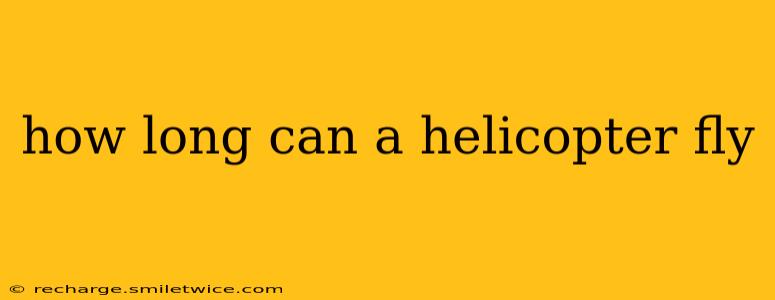How Long Can a Helicopter Fly? The Limits of Rotary Flight
The simple answer to "How long can a helicopter fly?" is: it depends. There's no single answer, as flight time is dramatically impacted by several key factors. Understanding these limitations is crucial to appreciating the capabilities and constraints of these amazing machines.
What Factors Determine Helicopter Flight Time?
Several factors significantly influence how long a helicopter can remain airborne:
-
Helicopter Model and Size: Larger helicopters with more powerful engines and larger fuel tanks will naturally have longer flight times than smaller models. A heavy-lift helicopter will have a vastly different endurance than a small, single-engine craft.
-
Fuel Capacity: This is arguably the most significant factor. The amount of fuel a helicopter carries directly dictates its maximum flight time. Larger fuel tanks translate to longer flights.
-
Payload: Carrying heavier loads, such as passengers, cargo, or external equipment, drastically reduces flight time. The added weight necessitates more fuel consumption, shortening the overall flight duration.
-
Weather Conditions: Adverse weather, including strong winds, heavy rain, or snow, increases fuel consumption and can significantly limit flight time. Pilots might need to land early for safety reasons.
-
Flight Profile: The type of flight significantly affects fuel consumption. Hovering, for instance, is incredibly fuel-intensive compared to level flight. Frequent climbs and descents, as well as rapid maneuvers, will also reduce flight time.
-
Maintenance and Engine Condition: Regular maintenance is vital for optimal performance and fuel efficiency. Engines in poor condition will consume more fuel and potentially limit flight time.
-
Pilot Skill: Experienced pilots can optimize fuel consumption through efficient flight techniques, extending flight time.
How Long Can Different Types of Helicopters Fly?
It's impossible to give precise numbers without specifying the helicopter model and flight conditions. However, we can offer some general ranges:
-
Small, single-engine helicopters: Might have flight times ranging from 2-4 hours under ideal conditions, often significantly less with payload.
-
Medium-sized, twin-engine helicopters: Can typically fly for 4-6 hours or more under optimal conditions, with flight times decreasing with heavier payloads and less favorable weather.
-
Heavy-lift helicopters: These are designed for heavy lifting and can have impressive flight times, sometimes exceeding 6 hours under ideal conditions, though this is heavily impacted by the weight they are carrying.
What About Range vs. Endurance?
It's important to differentiate between range (the maximum distance a helicopter can travel) and endurance (the maximum time it can remain airborne). A helicopter might have a long range but a relatively short endurance if it's designed for high-speed cruise flight. Conversely, a helicopter optimized for hovering might have a short range but a longer endurance.
Can Helicopters Fly Non-Stop for Extended Periods?
While some helicopters can technically fly for several hours, non-stop flights over exceptionally long durations are uncommon. Factors like fuel capacity, pilot fatigue, and maintenance requirements necessitate refueling and rest stops.
How Long Can a Helicopter Hover?
Hovering is extremely fuel-intensive. A small helicopter might only be able to hover for 15-30 minutes before needing to refuel, while larger helicopters might manage a bit longer.
In conclusion, the flight time of a helicopter is highly variable. To determine the precise flight time for a specific mission, you need to consider the above-mentioned factors and consult the relevant technical specifications for the helicopter model in question.
